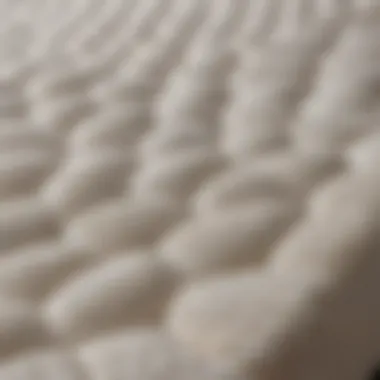Assessing Tempur-Pedic Mattresses and Back Health


Intro
When it comes to finding a mattress that best supports back health, the choice can feel like searching for a needle in a haystack. Tempur-Pedic mattresses often come up in conversations regarding sleep quality and spinal alignment. But are they truly the silver bullet for those suffering from back pain? This article seeks to dissect the layers, quite literally, of what these mattresses claim to offer. It is essential for homeowners and housewives alike to understand whether investing in a Tempur-Pedic could be a cornerstone for better back health or just a mere temptation wrapped in advertisements.
To navigate this journey, we will delve into key areas, including:
- The material characteristics that set Tempur-Pedic apart from standard mattresses.
- Expert opinions from orthopedic specialists and sleep scientists.
- Real-world user experiences that either validate or question the hype.
- Scientific studies backing either side of the mattress debate.
- An examination of sleep styles and back conditions, offering tailored insights for different scenarios.
The goal is not just to inform but to provide a thoughtful analysis that may aid in making an educated decision on whether a Tempur-Pedic mattress is worth the investment for better spinal health.
Understanding Tempur-Pedic Technology
Understanding the technology behind Tempur-Pedic mattresses is essential for anyone considering an investment in their sleep quality and back health. The innovations within these mattresses offer not just comfort but also promise significant benefits for spinal alignment and pain relief. In a world where sleep directly influences our overall well-being, examining how these mattresses function can make all the difference.
What Is Tempur Material?
Tempur material is a unique blend of viscoelastic foam, initially developed by NASA in the early 1970s for space shuttles. The core property of this material is its ability to respond to body heat and weight, conforming to the sleeper’s shape while providing support. Unlike traditional foam, that can feel stiff, Tempur gives a gentle hug, minimizing pressure points.
When you lie down on a Tempur-Pedic mattress, the foam molds to your body. This characteristic ensures that every curve and contour of your body is taken into account, offering a personalized experience. Hence, back pain sufferers often cite Tempur material’s pressure-relieving abilities as a significant advantage.
“The material feels like it’s cradling me. I wake up with less aches and pain,” says one satisfied user, reflecting an experience echoed by many.
How Does Tempur-Pedic Differ from Traditional Mattresses?
The difference between Tempur-Pedic mattresses and traditional mattresses is quite pronounced. Traditional innerspring or foam mattresses typically use a uniform structure where comfort layers sit atop a more rigid base. While these mattresses can be supportive, they often lack the adaptability and contouring properties of Tempur.
Here are a few key distinctions:
- Conformance: Tempur-Pedic mattresses adapt uniquely to the body, whereas traditional mattresses often provide static support that may not accommodate individual body shapes.
- Durability: Tempur material is designed to last. It doesn’t sag as quickly as traditional mattresses, which could lead to diminished support over time.
- Motion Isolation: If you share a bed, the Tempur material absorbs movement, so when one person shifts, the other feels minimal disturbance, unlike on innerspring mattresses where every movement can ripple across the surface.
In summary, understanding Tempur technology allows potential buyers to appreciate the distinct benefits this innovative material brings to improving sleep quality and back health. This knowledge positions them to make informed choices that could bolster their overall health and comfort at night.
The Science of Sleep and Back Health
Understanding the science behind sleep and its impact on back health is crucial when evaluating the performance of Tempur-Pedic mattresses. Sleep is not merely a period of rest; it plays a vital role in physical recovery, mental health, and overall wellness. When it comes to spinal health, the quality of sleep directly influences back pain and discomfort. Many housewives and homeowners struggle with sleep-related issues that stem from inadequate mattress support. Choosing the right mattress could vastly improve sleep quality, and in turn, enhance back health.
Importance of Spinal Alignment during Sleep
Spinal alignment during sleep is paramount for maintaining back health. When we sleep, our bodies should ideally be aligned in a way that supports the natural curvature of the spine. If the alignment is off, it may lead to undue pressure on specific spinal regions, resulting in pain over time.
- Good alignment means that the spine maintains its natural S-shape, reducing stress on muscles, joints, and ligaments.
- Lack of spinal alignment can lead to chronic pain, discomfort, and even contribute to conditions like sciatica or herniated discs.
Most traditional mattresses offer varied levels of firmness, which can either support or hinder proper alignment. Tempur-Pedic mattresses, with their unique memory foam technology, aim to conform to the sleeper's body, promoting an ideal alignment that cradles the spine. Users often report waking up with less stiffness and fewer aches, which can be attributed to this focus on spinal health.
Common Sleep Positions and Their Impact on Back Health


The way one sleeps can greatly affect back health. People generally favor certain positions, all of which have implications for spinal support:
- Back Sleepers: This position is often praised for supporting spinal alignment, provided that the mattress properly supports the lower back and neck. Tempur-Pedic mattresses adapt well here, allowing the spine to rest in a neutral position.
- Side Sleepers: Side sleeping often requires additional cushioning around the shoulders and hips to avoid pressure points. A mattress that sinks slightly at these regions can aid alignment and lessen strain on the lower back.
- Stomach Sleepers: This is the least recommended position as it can create unnatural twists in the neck and spine, leading to discomfort. Those who sleep on their stomach often benefit from a firmer mattress that minimizes sinking.
It's worth noting that individual preferences and body types will influence the best sleeping posture. A suitable mattress, like those from Tempur-Pedic, can mean the difference between a good night's sleep and waking up feeling like you were run over by a truck.
Research from various sleep studies indicate that poor sleep posture can lead to chronic back pain. Choosing the right mattress is an important step toward correcting these issues.
In summary, the science of sleep underscores the relationship between mattress choice, spinal alignment, and overall back health. Tempur-Pedic mattresses stand out for their ability to cater to multiple sleeping positions while encouraging proper alignment. This combination can potentially reduce back pain and enhance sleep quality, making it a worthy consideration for those prioritizing their health.
Do Tempur-Pedic Mattresses Support Back Health?
When it comes to a good night’s sleep, the mattress plays a pivotal role, particularly for those prone to back discomfort or chronic pain. Tempur-Pedic mattresses have been marketed as a solution for enhancing back health, but the question remains: do they truly deliver on this promise? The importance of examining the relationship between Tempur-Pedic mattresses and back support cannot be overstated. Many people spend a significant chunk of their lives in bed, and the quality of that rest can have profound effects on overall health.
Tempur-Pedic mattresses are often celebrated for their unique material that adjusts to the body’s contours. This capability can be particularly beneficial for spinal alignment, as a well-aligned spine during sleep can help mitigate discomfort and promote better health. In this section, we will delve into user experiences and testimonials, as well as insights from medical professionals, providing a comprehensive understanding of how these mattresses may—or may not—foster back health.
User Experiences and Testimonials
Individual experiences with Tempur-Pedic mattresses vary widely, but common themes tend to emerge from user reviews. For many, the relief from pressure points has been a game-changer. Users frequently report a significant drop in nightly tossing and turning, which can contribute to a more restorative sleep cycle. Furthermore, individuals who had endured sleepless nights due to back pain often find solace in the adaptive properties of the Tempur material.
- Comfort Over Time: Many users initially experience a different sensation compared to traditional mattresses. As time goes on, however, there have been reports of acclimatization, leading to greater comfort and an improved sense of support as the material conforms to body shapes.
- Anecdotal Accounts: One individual from a discussion on reddit.com mentioned, "I never thought I'd sleep without pain again, but now I wake up feeling refreshed instead of like I was hit by a truck!" These stories often highlight that tangible relief can come with consistent use over a period of time.
- Adjustable Preferences: Aside from the physical comfort sparked by the material, some users appreciate the adaptability of the mattress to personal preferences, allowing for adjustments in firmness levels. This adaptability can be crucial since back health solutions are often not one-size-fits-all.
Reviews from Medical Professionals
Not only do users offer valuable perspectives, but insights from medical professionals also lend significant weight to the discussion around Tempur-Pedic mattresses and back health. Various healthcare practitioners have studied the design and material properties of these mattresses and what they mean for back support:
- Chiropractic Perspectives: A chiropractor might advocate for the TMattress, citing how it promotes spinal alignment through even distribution of body weight, particularly for back sleepers. This view aligns with recommendations for maintaining the natural curvature of the spine during rest.
- Pain Management Specialists: In a clinical setting, pain management specialists often suggest regular use of supportive mattresses like Tempur-Pedic to facilitate recovery processes in patients experiencing chronic pain. One such specialist mentioned that “the body’s natural alignment during sleep is crucial for repair and recovery, and Tempur-Pedic excels in offering that.”
- Skeptical Voices: Not everyone is sold on the Tempur-Pedic bandwagon; some professionals point out that choosing a mattress depends heavily on individual body types and preferences, maintaining that the best mattress is ultimately the one that feels most comfortable to the sleeper.
"A mattress should support you both when you sleep and when you wake. Not all brands achieve this effectively for everyone—a personalized approach is often necessary."
— Dr. Jane Smith, Sleep Specialist.
While the overall narrative about Tempur-Pedic mattresses often leans towards positivity, it is clear that personal adjustment and medical advice play critical roles in their efficacy for back support. Understanding these multifaceted experiences and expert reviews can help individuals make informed choices about their sleep habits and mattress investments.
Potential Benefits for Back Pain Sufferers
When considering a mattress for back pain, it’s crucial to look beyond mere comfort. The potential benefits offered by specific mattresses, especially Tempur-Pedic, have garnered significant attention. These are not just about achieving a restful night’s sleep but also addressing the unrelenting challenges posed by back pain.
There are several specific elements that merit discussion in this context:
- Individual Needs: Not all back pain is the same, and neither should mattress solutions be uniform.
- Material Properties: Tempur-Pedic mattresses are engineered to adapt to body shapes and weights, providing targeted support.
- Pain Management: Understanding how different aspects of mattress design contribute to alleviating pain is essential.
Pressure Relief and Its Role in Pain Management
The significance of pressure relief cannot be overstated for those suffering from back pain. People typically spend around a third of their lives asleep, and if one's sleeping surface fails to distribute weight properly, it can exacerbate discomfort and lead to restless nights. Tempur-Pedic mattresses employ a unique foam that conforms specifically to the body's contours.
- Reduced Pressure Points: This material helps in minimizing pressure points that often lead to discomfort and pain. Back sleepers, side sleepers, and stomach sleepers may all experience different pressure variations. A good mattress should alleviate these points to maintain alignment and comfort.
- Even Weight Distribution: Unlike traditional mattresses, which may sag or create valleys, Tempur-Pedic aims for an even distribution of body weight across its surface. The goal is to ensure that the spine remains in a neutral position throughout the night.
"The mattress you choose can be a game changer, not just for comfort but also for your overall health."


Motion Isolation and Its Effects on Sleep Quality
Another noteworthy aspect of Tempur-Pedic mattresses is their motion isolation capability. In many households, sleep can be disrupted by a partner shifting positions or getting out of bed. The Tempur material excels at absorbing motion, which can be quite beneficial for those with back pain.
- Stability during Movement: When one person moves, the other is less likely to feel or wake from the motion. This stability can help maintain uninterrupted sleep cycles that are so crucial for recovery.
- Sleep Quality: Studies show that consistent sleep disturbance can lead to chronic pain over time. A mattress that prevents disruptions can aid in improving overall sleep quality, which is a critical factor in managing back pain effectively.
Considerations and Limitations
When diving into the world of Tempur-Pedic mattresses and their impact on back health, it’s vital to take a step back and assess various considerations and limitations that may influence your decision-making. While numerous benefits come with these mattresses, each individual’s circumstances can sway the overall effectiveness of such support. It’s not a one-size-fits-all scenario.
Weight and Firmness Preferences
Weight and firmness preference is crucial when selecting a mattress. Different body types respond uniquely to varying firmness levels. Heavier individuals might find a firmer mattress beneficial, as it provides the necessary support to maintain proper spinal alignment. If the mattress is too soft, it may lead to excessive sinking, which can cause misalignment and discomfort.
Conversely, lighter individuals often prefer a softer mattress; it allows them to sink in enough to feel comfortable without compromising support.
In general:
- Heavier individuals: A firm mattress may help support the natural curve of the spine.
- Lighter individuals: A softer surface often ensures proper foam conformance to the body’s shape.
Understanding your weight distribution and preferred firmness level is paramount in maximizing back health while using a Tempur-Pedic mattress. Finding that balance can transform your sleep quality from restless to restful.
Temperature Sensitivity and Sleep Environment
Tempur-Pedic mattresses are often recognized for their memory foam properties, which can sometimes retain heat. This temperature sensitivity can significantly impact sleep quality, particularly if you or your partner tends to get hot during the night. While some models have introduced cooling technologies, this has not completely eliminated concerns regarding warmth.
Here are some factors to consider:
- Room Temperature: Keeping the bedroom cool can help enhance the cooling effect of your mattress.
- Bedding Material: Using breathable sheets can also aid in maintaining a comfortable sleep environment.
- Personal Preference: Some individuals may adjust over time to the warmth of memory foam, but others might find it stifling.
"Every individual's needs and preferences are as diverse as the fabrics on their beds; understanding those nuances can lead to better health—and better sleep."
Being informed about these matters aids housewives and homeowners alike in making educated choices, ultimately steering them toward a solution that may better serve their back health.
Comparative Analysis with Other Mattress Types
When it comes to achieving a restful night's sleep, the type of mattress plays a pivotal role, especially for those grappling with back issues. The comparative analysis of Tempur-Pedic mattresses with other mattress types, such as latex and innerspring mattresses, is crucial. It reveals important considerations regarding support, comfort, and durability. In this section, we dissect how Tempur-Pedic stacks up against these alternatives, making clear distinctions that will assist you in your mattress decision journey.
Latex vs. Memory Foam: A Comparison
Latex mattresses and Tempur-Pedic mattresses made from memory foam are often pitted against each other regarding back support and comfort. Let’s break down the aspects that matter:
- Responsiveness: Latex tends to bounce back quickly after pressure is removed, providing a more buoyant feel. This can be particularly advantageous for individuals who shift positions frequently at night. In contrast, memory foam from Tempur-Pedic cradles the body, allowing for a snug fit that can reduce pressure points.
- Temperature Regulation: Latex mattresses typically allow for better airflow than memory foam, meaning they might keep you cooler at night. Tempur-Pedic products often retain heat due to their density, which some sleepers might find uncomfortable, especially in warmer climates.
- Durability: Latex is highly durable, often lasting longer than memory foam options. Tempur-Pedic mattresses, however, offer excellent long-term performance if maintained properly, making them a potentially good investment for back health.
- Support: Both types excel at providing support; however, the choice can hinge on personal preference. Some may find latex to be more supportive overall, while others may prefer the conforming nature of memory foam, particularly if they sleep on their sides.
In summary, the choice between latex and Tempur-Pedic memory foam hinges on individual preferences regarding firmness, temperature, and level of support.


Innerspring vs. Tempur-Pedic: Which Is Better for Your Back?
Comparing Tempur-Pedic with innerspring mattresses reveals some fundamental differences that could affect back health. The nuances are significant:
- Support System: Innerspring mattresses rely on a system of coils for support. While they can offer decent spine alignment, their effectiveness often depends on the quality and arrangement of the springs. Tempur-Pedic mattresses use viscoelastic foam which contours to the body, helping with spinal alignment more effectively by distributing weight evenly.
- Motion Transfer: When one person moves on an innerspring mattress, the other can often feel it. This can disrupt sleep quality for couples. Tempur-Pedic mattresses are designed to minimize motion transfer, making them ideal for a peaceful night’s rest, even if one sleeper is restless.
- Longevity: Innerspring mattresses typically do not last as long as Tempur-Pedic mattresses. The latter may sag less over time and maintain their supportive qualities longer, provided they are kept in good condition.
- Comfort Level: Innerspring beds often provide a more traditional feel, which some people might prefer. However, those with back pain might benefit more from the contouring nature of Tempur-Pedic foam, which offers targeted relief.
"The right mattress can be a game-changer for managing back pain and ensuring restorative sleep."
Weighing these aspects serves as guidance for housewives and homeowners who prioritize both comfort and functionality in their sleeping arrangements. Understanding these distinctions can guide your quest for the ideal mattress tailored to your specific needs.
Expert Recommendations for Choosing a Mattress
In the realm of sleep wellness, selecting the right mattress is paramount, especially for those grappling with back pain. The nuances of individual preferences, body types, and sleep positions greatly influence the decision-making process. Therefore, this section aims to provide insightful recommendations tailored to various needs, illuminating the critical aspects that come into play when choosing a mattress that promotes spinal health.
Guidelines Based on Sleep Position
Different sleep positions can elicit unique demands on a mattress’s support and firmness levels. Here, we unpack recommendations best suited for specific sleep styles:
- Back Sleepers: For individuals who prefer sleeping on their backs, a medium-firm mattress, such as a Tempur-Pedic, provides optimal spinal alignment. The material conforms to the body’s natural curvature, offering support where it’s needed while alleviating pressure points, especially under the lumbar region.
- Side Sleepers: For those who are partial to the side-sleeping position, a slightly softer mattress is recommended. This allows for better hip and shoulder cushion, which prevents unnecessary strain. Tempur material can contour nicely around these pressure points, thus aiding in reducing pain for side sleepers.
- Stomach Sleepers: Those who sleep on their stomachs might require a firmer surface to prevent the hips from sinking too far and causing misalignment. While Tempur-Pedic mattresses are generally designed with support in mind, it’s crucial for stomach sleepers to select a model that offers adequate firmness.
By understanding these guidelines, individuals can better align their mattress choice with their sleeping habits, resulting in a restful night.
Consulting with a Health Professional
Before making a significant change in your sleep setup, it can be wise to consult with a healthcare professional. Especially when back health is concerned, an expert can provide personalized advice. Here are a few reasons why this step should not be overlooked:
- Personalized Assessment: Health professionals can assess your specific condition and recommend features that might be beneficial for your back. Whether that ranges from mattress firmness to specific materials, their expertise can guide you towards a fitting choice.
- Understanding Specific Needs: If you have particular health conditions—like sciatica or degenerative disc disease—these experts can suggest mattresses designed to relieve discomfort associated with these conditions.
- Trial and Error: Often, professionals can recommend a period of trial with different mattresses. They might even provide insights on what to look for during sleep tests to determine the mattress that suits you best.
Involving a health professional in your mattress decision-making ensures that you'll make a choice that not only enhances sleep quality but also promotes long-term back health.
"A good night's sleep is not just about comfort; it's about supporting your body's needs to ensure health and wellness." - Anonymous
Making an informed decision about your mattress is essential for sustaining back health. With tailored recommendations based on sleep position and the guidance of health professionals, individuals can pave the way for better sleep and overall well-being.
Ending: The Final Verdict
In any exploration of back health, the conversation around mattresses becomes paramount, especially when evaluating a prominent option like Tempur-Pedic. Their unique structure and material seem to provide more than just a place to rest our heads; they offer a medium that might align with the needs of many individuals suffering from back pain. Understanding how these mattresses can support spinal health is not just a trivial pursuit—it’s crucial for anyone making decisions about their sleep environment.
Summarizing the Evidence
To wrap it up, the evidence collected throughout this article points to several compelling features of Tempur-Pedic mattresses. Studies and user testimonials repeatedly highlight:
- Pressure Relief: The adaptive nature of Tempur material allows it to conform to the body’s shape, offering relief to sensitive areas.
- Spinal Alignment: With the right support, these mattresses encourage proper posture during sleep, which is essential for spinal health.
- User Experiences: Many users report significant reductions in pain after switching to Tempur-Pedic, a touchstone for its effectiveness.
It's also imperative to weigh in on differing opinions from medical professionals, who often see varied results based on individual cases. Thus, while the general consensus tends to favor the benefits, one cannot ignore that individual experiences may fluctuate based on specific needs and body types.
"Choosing a mattress is not just about comfort; it’s about investing in one’s health and wellbeing every night."
Personalizing Your Mattress Decision
When declining into the world of mattress choices, sticking to one blanket statement about all Tempur-Pedic mattresses fits no one. This decision is highly personalized.
- Evaluate Sleep Position: Consider whether you sleep on your back, side, or stomach. Each position may require different levels of firmness to maintain proper alignment.
- Assess Body Weight: Heavier individuals may require firmer options for adequate support, while lighter individuals might prefer softer surfaces.
- Temperature Preferences: Some Tempur-Pedic options incorporate cooling technology. If you tend to heat up during the night, a model with this feature might be more suitable.
Engaging with appropriate resources such as user forums on reddit.com or even checking community feedback on social media platforms like facebook.com can provide additional insights.
Making an informed choice about your mattress could be the difference between restful nights and sleepless struggles. While Tempur-Pedic presents an attractive case for back health, it remains essential to tune into your individual needs and preferences.















